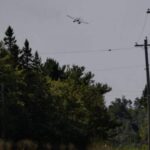A dense veil of smoke has descended upon vast portions of central Canada this week as dozens of wildfires continue to rage across the Prairie provinces, creating a cascading health crisis that extends far beyond the immediate danger zones.
The fires, primarily concentrated in Saskatchewan and Manitoba, have triggered air quality warnings in communities hundreds of kilometers from the actual blazes, demonstrating the far-reaching environmental consequences of these increasingly common natural disasters.
“What we’re witnessing is a troubling pattern of intensification,” explained Dr. Sarah Michaels, an environmental health specialist at the University of Regina. “The combination of drought conditions, higher-than-average temperatures, and shifting wind patterns has created perfect conditions for both fire spread and smoke distribution across provincial boundaries.”
In Regina, where visibility has been reduced to less than a kilometer at times, residents report a persistent smell of burning wood and ash that permeates even well-sealed homes. Air quality index readings have reached “very high risk” levels above 150 in multiple communities, prompting health authorities to advise vulnerable populations to remain indoors.
The Canadian Interagency Forest Fire Centre reports that over 85 active fires are currently burning across the Prairie provinces, with nearly 40% classified as “out of control.” Particularly concerning are large-scale fires near populated areas, including a 8,000-hectare blaze approaching the Manitoba-Saskatchewan border that has forced the evacuation of three small communities.
“These aren’t just local events anymore,” noted Raj Bhardwaj, Chief Meteorologist at Environment Canada’s Winnipeg office. “The atmospheric transport of particulate matter means that communities in Ontario and even parts of Quebec are experiencing reduced air quality despite being hundreds of kilometers from any active fire.”
Economic impacts are mounting alongside the health concerns. Agricultural operations across the region report significant disruptions, with visibility issues hampering harvesting operations and smoke potentially affecting crop quality. Tourism has also taken a substantial hit, with bookings down nearly 40% at popular outdoor destinations throughout the affected regions.
Provincial authorities have mobilized additional resources to combat the fires, including deploying water bombers and specialized firefighting units from neighboring provinces. The federal government has also authorized military support for evacuation and firefighting efforts in the hardest-hit areas.
“This requires a coordinated response across all levels of government,” stated Minister of Emergency Preparedness Anita Anand during a press briefing in Ottawa yesterday. “We are allocating additional resources to support provincial efforts and ensure communities have what they need to protect their residents.”
Climate scientists point to these intensifying wildfire seasons as evidence of broader climate change impacts affecting the Canadian landscape. Research published in the Canadian Journal of Forest Research indicates that fire seasons have lengthened by nearly three weeks over the past four decades, with more intense burning periods becoming increasingly common.
Health officials urge residents in affected areas to monitor local air quality reports, limit outdoor activities when conditions deteriorate, and ensure proper filtration systems are functioning in homes and businesses. Particularly vulnerable populations—including children, elderly individuals, and those with respiratory conditions—are advised to take extra precautions.
As Canadians across multiple provinces continue to cope with this invisible threat, many are left wondering: Will these extended wildfire seasons and their wide-ranging impacts become the new normal for our summers, and what long-term adaptations will communities need to make to protect public health in this changing environmental landscape?
























